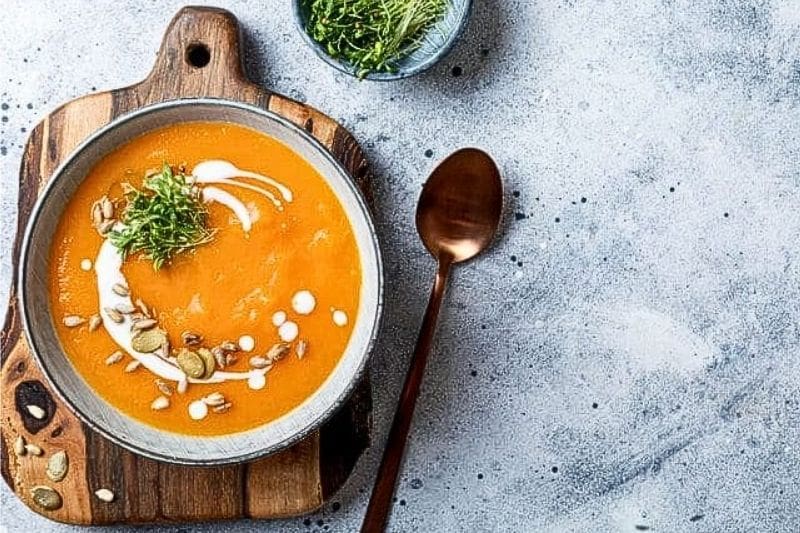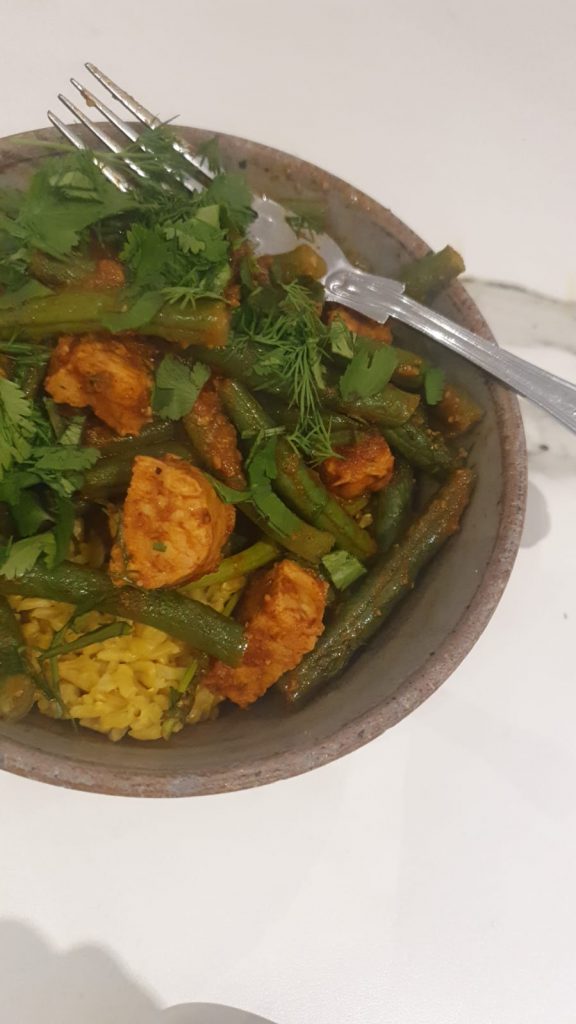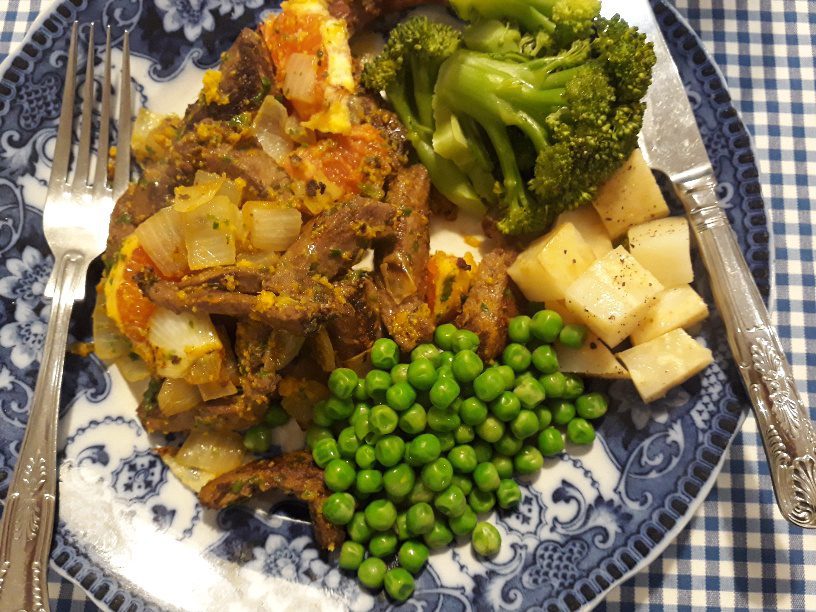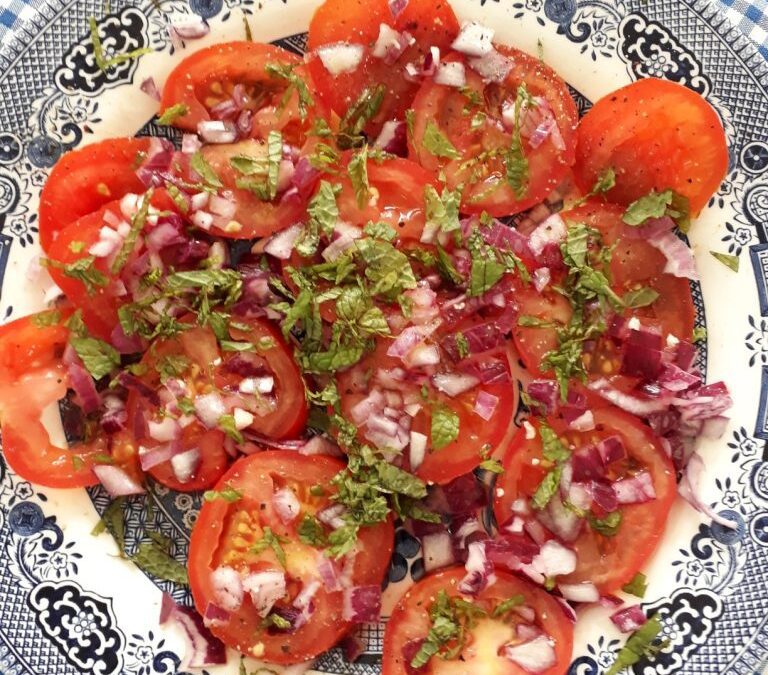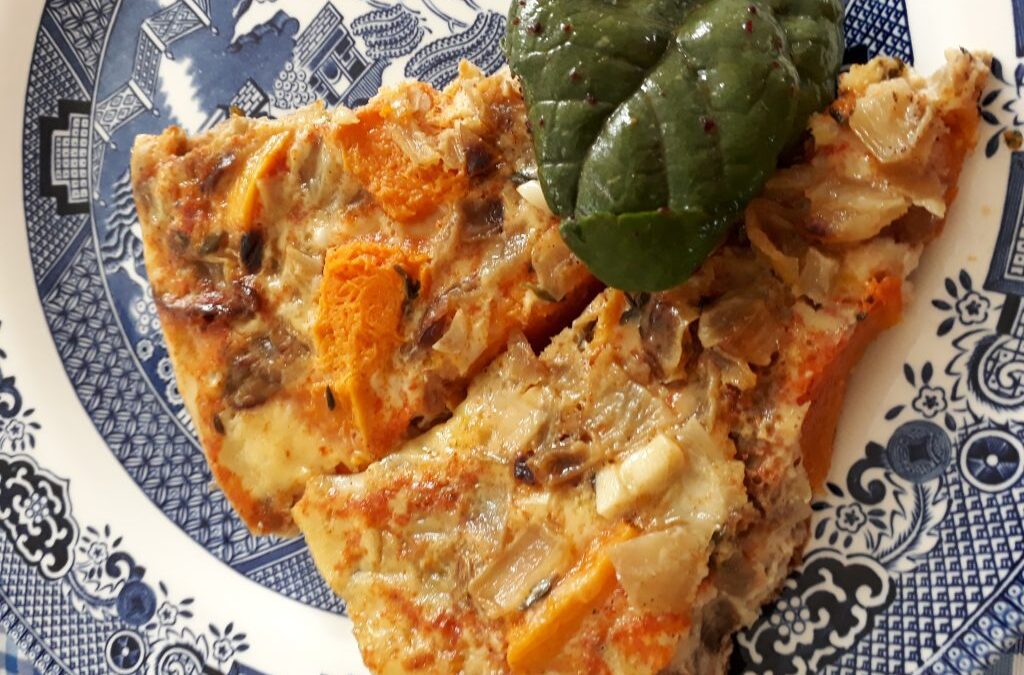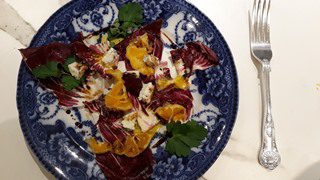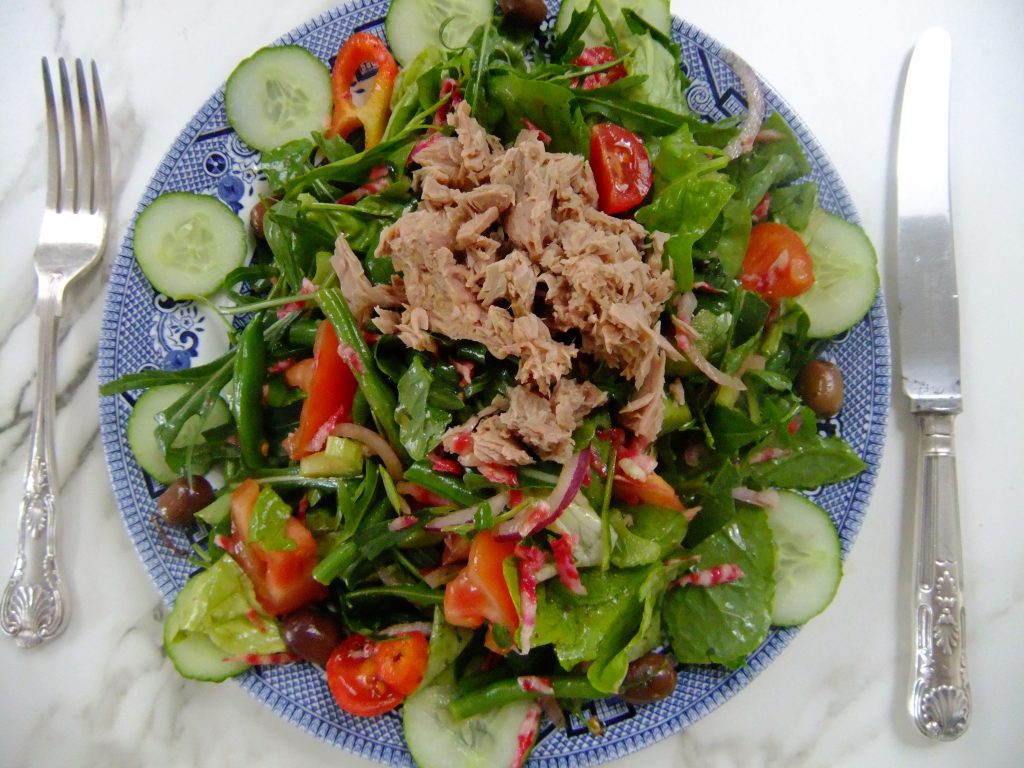
Sep 28, 2023 | Anna's Best Recipes, Main courses, Sides, starters, soups & snacks
Now Autumn’s here and with it some crazy storms I’ve rediscovered this high protein immune-supporting soup that’s a bowl full of sunshine. To make it into a complete meal add a cupful of cooked greens per person at the end (a bag of baby spinach would do). If you want to gain weight, add some extra carbs such as wholemeal gluten-free bread or leftover cooked rice (reheat well in the soup). If you eat gluten) some 100% rye or wholemeal sourdough. This soup freezes well too.
For 4
Note: You can save yourself effort chop all veg and spices only roughly if you’re going to blend the soup later on.
1 very large onion or 2 medium chopped onions
2 large sticks celery, sliced
2 large carrots (about 300g), sliced
2 heaped tbs (tablespoons) finely grated fresh ginger
1-2 rounded tbs ghee or virgin coconut oil (if you have an inflamed gut, ghee is best).
3 cloves garlic, crushed
Heaped teaspoon turmeric powder
Heaped teaspoon coriander powder
1/2 level tsp ground cardamom powder if you have it
500ml carton of passata (sieved tomatoes) or a 400g can chopped tomatoes
750ml filtered water or leftover vegetable cooking water (e.g. from steaming veg)
250g (mug and a quarter) dried red lentils
1 heaped tsp health store additive-free vegetable stock powder (for the SC Diet use Dr Coys Organic Vegetable Bouillon)
Freshly ground black pepper
1. Heat a large heavy-bottomed saucepan with lid on a medium heat for a minute. Add ghee/oil, onion, celery, carrots, ginger and a small splash of water, cover with a lid and sweat for 10 minutes.
2. Add garlic, turmeric and cardamom if you have it, stir for a minute before adding passata/tinned tomatoes and water.
3.Give everything a stir then add the lentils so they sit on top (otherwise during cooking they stick to the bottom). If the lentils are not entirely submerged in liquid, add a bit more water or stock.
4. Boil for 15-20 mins for 20 mins/until lentils and veg are soft. Only stir the lentils gently at the very top if they are stuck together, otherwise leave them alone.
5. Mix the veg stock powder into a little water and add to the soup AFTER the the lentils are soft (otherwise salt makes the lentils touch).
4. If you want a smooth soup now give it a whizz with a stick blender.
5 reasons this is good for you:
Lentils and onions contain prebiotic fibre. This feeds friendly bacteria you need for healthy digestive system and immunity.
Turmeric, ginger, garlic, coconut oil, cardamom and coriander reduce numbers of disease-causing bacteria/viruses in your gut.
Processed cooked tomatoes are the richest source of antioxidant lycopene to help ALL of you
Ghee contains butyric acid, a metabolite produced by friendly bowel bacteria to keep your gut and immune system tip-top.
Lentils are a rich and easy-to-digest source of protein which is essential for antibody production to protect against infection.

Jan 30, 2022 | Anna's Best Recipes, Main courses
This is my current favourite way to use tofu or tempeh. I adapted it from Ottolenghi’s more complex recipe. My husband is a tofu-hater so when he disappears for a few days I always cook this. Keep in mind that unfermented soya products contain digestion-blocking proteins that damage your gut. So DO make sure to buy the fermented forms for this dish: tempeh or fermented tofu (it will say on the pack).
If you don’t have a small-bowl food processor, chop the chili finely, crush the garlic and use a pestle and mortar to bash the caraway seeds about as much as you can before mixing with the other spices and oil.
For 2
This is gorgeous served with cauliflower/broccoli “rice”, konjac noodles or brown basmati rice.
350g trimmed French (or use runner beans cut in 6cm bits)
Salt and black pepper
200g non-GMO tempeh or fermented tofu, cut into bite size cubes
A few sprigs of dill (small handful), destalked and roughly chopped
Small handful fresh coriander, destalked and roughly chopped
For the sauce:
4 garlic cloves, peeled and crushed
1 green or red chili, deseeded (optional)
2 slightly rounded tsp sweet paprika
1 tbs caraway seeds
1.5 tsp ground cumin
½ level tsp ground Ceylon cinnamon
2 tbs + a little extra avocado oil or extra virgin olive oil
3 tbs tomato puree
250ml water or leftover vegetable-steaming water (full of nutrients!)
Optional: 1 heaped tsp honey or non-toxic sweetener e.g. Dr Coy’s Stevia Erylite or xylitol (from good health stores)
2 limes
Black pepper
Himalayan or sea salt
- For the sauce put the garlic, spices, chili and 2 tbs oil in the small bowl of the food processer and blitz to a thick paste. You might need a touch more oil to bring it together.
- Heat a pan on a medium heat and add a teaspoon more of avocado/olive oil and stir fry the garlic-spice mix for 30 seconds.
- Then add the tomato puree, 250ml water and bring to the boil.
- Stir in the honey or non-toxic sweetener, lime juice, generous pinch (1/4 a level tsp) salt and a few good grinds of black pepper.
- Add the tempeh, turn down the heat, cover and simmer while you prep the green veg.
- Steam the French/runner beans for around 2-3 minutes until the colour changes very slightly and they are softened but still have a bit of crunch.
- Finally, just before serving, stir the herbs into the tofu and sauce, pile on top of your rice and enjoy.
Serve with:
Low carb: Cauliflower or broccoli rice https://www.annacollins.ie/cauliflower-rice/ or konjac noodles from Asian stores.
Medium carb: brown basmati rice cooked with a generous pinch of turmeric
Why this is good for you:
Spices are a powerhouse of antioxidants that help rebalance your gut bacteria in favour of the good guys. The good guys helps digest your food, repair and maintain your gut lining every minute of every day, and reduce inflammation in you. This has massive implications for your immune system, your gut health and even your mood. Yes, anxiety/depression states always involve brain inflammation. Type the name of just one spice into medline (the scientific journal resource) and you’ll find hundreds of peer-reviewed scientific studies.

Oct 3, 2021 | Anna's Best Recipes, Sides, starters, soups & snacks
I love this and I’ve made it so many times now I don’t need a recipe. Make it as cauliflower “steaks” or florets (a bit faster).
If you prefer an Indian vibe use a spice blend of 1 level tsp each of ground cumin, coriander and turmeric alongside the pepper and salt.
1 whole cauliflower, green leaves removed
1 heaped tsp ground sumac or sweet paprika
Freshly ground black pepper
Pink (Himalayan) salt
Extra virgin olive oil (about 2-3 tbs)
Roast cauliflower “steaks”
Preheat oven to 215c/200C fan
With the cauliflower standing on its stalk, slice it downwards into 1.5-2cm slices. You’ll get 4-5 good “steaks” and some shards.
Brush the roasting tin with extra virgin olive oil lay the cauliflower slices on top rubbing them around a bit to coat with the oil without breaking them up.
Brush the tops with olive oil, sprinkle with the sumac/paprika, lots of freshly ground black pepper and a generous pinch of salt.
Roast 15-20 mins at 200C. It’s done when the edges are starting to char.
Roast cauliflower florets
Take out central thick stalk from the cauliflower and break into small florets.
Put in the roasting dish, drizzle on extra virgin olive oil, sprinkle on your spices, pepper and salt and toss to coat.
Roast 10-15 mins at 220c/fan 200c.
Its done when the edges are starting to char.
If you feel like a fancier recipe with a delicious middle eastern dressing go to my blog post https://www.annacollins.ie/oven-roasted-cauliflower-green-bean-salad/

Oct 23, 2020 | Anna's Best Recipes, Main courses
My mother sent me the recipe cut out of the newspaper and I love it. Just the thing for a cold, dark Autumn night as we all stay in our houses. Many of my patients find that a paleo-style diet (vegetable-rich, virtually grain-free, dairy-free with meat, fish, eggs and good fats) makes them feel SO much better than a so-called “healthy diet” that is overloaded with grains and potatoes. The proof of the pudding is in the eating. This pot roast comes with its own gorgeous rich brown sauce. I love this pot roast because its delicious on the day and I can use leftovers sliced and either reheated in the sauce. Leftovers are your friend if you love eating well but don’t want to spend hours every night in the kitchen. We often eat this with cauliflower mash and a steamed green vegetable like cabbage, broccoli or green beans. Yum…
If you want to feed resolute carnivores and those who want to eat less red meat at the same meal simply add cooked butterbeans about 20 minutes before the end of cooking. They take up the fabulous flavour and are rich in protein.
1kg pot-roasting beef (housekeepers’s cut or topside). This will come tied up with string which stays on till you serve it.
Extra virgin olive oil
2 tbs tamari sauce (avoid if on SC diet)
6 tbs dry white wine
2 star anise (this makes the sauce extra flavoursome)
1 large/2 small cloves garlic, roughly chopped
1 rounded teaspoon raw cane molasses
Freshly ground black pepper to taste
2 onions, each peeled and cut in 8 wedges
2 large carrots, diced roughly
1 heaped tsp arrowroot powder (from health shops) to thicken
1. Preheat a heavy casserole, then add a knob of extra virgin olive oil and sear the beef for a minute each side until very lightly browned (browning isn’t essential, you can go straight to step 2 if you want).
2. Add the tamari sauce, wine, star anise, garlic, close tightly and simmer gently o the top of the stove or in a low oven or slow cooker for an hour.
3. Meanwhile dice the carrots roughly, peel and cut each onion into 8 wedges.
4. Add the molasses, some freshly ground black pepper, carrots, onion, and continue to cook very gently for a further 1½ hours. When cooked, remove the beef and keep warm.
5. If you want to increase the amount of sauce, add a little water (or some leftover vegetable-steaming water).
6. Blend a teaspoonful of arrowroot with a little water, add in a little of the hot liquid, then add to the juices in the casserole and bring up to the boil, stirring, until the sauce thickens and clears.
Serve with:
LOTS of steamed green veg and some mashed Swede turnip or cauliflower mash.
Why this is good for you:
Long slow cooking is much preferable to cooking at high temperatures because fewer toxic byproducts are created to would cause more inflammation in your body. For this reason, browning a single large piece of meat is better than browning small pieces. When I’m feeling really healthy I don’t brown this pot roast at all and it still tastes delicious – the sauce is so rich. Red meat contains acetyl-carnitine. For people with serious energy problems (eg M.E./chronic fatigue syndrome/long covid) eating foods that contain acetyl-carnitine every day can bring about great improvements in energy.

Jul 6, 2020 | Anna's Best Recipes, Sides, starters, soups & snacks
Had this last night with some herb roast chicken and roasted cauliflower sprinkled with sumac. Fab. the recipe is courtesy of Domini Kemp and Patricia Daly’s Ketogenic Kitchen. If you are doing ketogenic diet and want to track carbs, protein etc, get the fatsecret app – even the free version is great.
For 4
4 large ripe beef tomatoes (1200g) 0r equivalent weight of vine tomatoes
Natural Himalayan/sea salt
Black pepper
1 medium red onion, finely diced
Small bunch of mint, finely chopped
1 large garlic clove, crushed
80ml extra virgin olive oil
Juice of 1 lemon or a splash of sherry vinegar
Macronutrients per serving: Net carbs 12.2g, protein 2.8g, fat 25.9g, fibre 4.1g
- Slice tomatoes into rounds, lay the slices out on a platter and sprinkle with salt.
- Leave for 20 minutes or more. This makes the tomatoes release their juices.
- Drain off juices and whisk together with the other ingredients.
- Add freshly ground black pepper to taste, and pour the dressing over the tomatoes. Serve.
Why this is good for you
Did you know that every vegetable, herb, spice and fruit contains a range of polyphenols (sorry, potatoes and bananas don’t contain many!). Polyphenols defend plants against threats e.g. viruses, fungi, bacteria, predators and UV rays. When you eat polyphenols they help strengthen all your body tissues and protect you against all chronic health conditions . Organic plants have more polyphenols because they are exposed to attack. They are not cocooned by pesticides and herbicides (herbicides kill soil bacteria). Attack stimulates plants to upregulate their defences – polyphenols. It’s a bit like when you train at the gym – you tear muscle fibres and the damage stimulates muscle to grow back bigger and stronger.
We absolutely need to be eating a wide range of plants including herbs and spices, over the course of every week. Tomatoes, mint, extra virgin olive oil, lemon juice, garlic all contain a big range of polyphenols. Tomatoes alone contain hydroxycinnamic acids, flavanones, flavonols, and anthocyanins, rutin and kaempferol-3-rutinoside and a lot of naringenin chalcone.
Raw extra virgin olive oil is a fantastic source of vitamin E. Vitamin E is anti-viral because it helps vitamin C work longer in your body. It also moisturises all your surfaces, outside and in. It is essential for the health of your heart, your skin, your brain, everything. Only VERY expensive vitamin E supplements contain the full range of vitamin E compounds. But if you eat many plants, a variety of raw nuts and seeds, lots of extra virgin olive oil and your digestive system is working perfectly you will be getting more vitamin E than most.

May 27, 2020 | Anna's Best Recipes, Main courses
I love stir fries especially when I want to use up what’s lurking in the bottom of the fridge. I think there are 6 elements in a good stir fry:
1. Aromatics: ginger, tamari sauce plus Chinese 5 spice powder or Szechuan pepper
2. Onions or spring onions
3. Vegetables: greens plus something else brightly coloured
4. Extra virgin coconut oil and/or chicken stock for the actual stir frying and cooking
5. Protein: e.g. chicken fillets, beef sirloin, tempeh, fermented tofu, prawns
6. Extra liquid: I like a glug of white wine/dry sherry and/or a chicken/veg stock/water
One of the keys is to have all ingredients totally prepped before you start to stir fry, that way the actual cooking can take as little as 10 minutes. Get your accompaniment (rice/cauliflower rice/noodles) ready and waiting in a warm place before you start stir frying.
Once you are used to making stir fries you’ll start adding your own twists, using additional veggies and making this your own.
For 2
1 heaped teaspoon extra virgin coconut oil
1 large onion (about 200g is nice)
2 large red peppers/2 medium carrots (or 1 pepper 1 carrot)
1 thumb of ginger (enough to make a heaped dsp or a bit more)
2 large cloves of garlic, finely chopped
1 heaped tsp Chinese 5 spice powder – if you make your own it’s amazing https://www.annacollins.ie/chinese-five-spice-powder/
2 large handfuls greens: e.g. green cabbage/kale, pak choi, or 2 cups small broccoli florets
Tamari sauce – about 2 tbs
Optional – about 2 tbs white wine or dry sherry
50-100ml vegetable or chicken stock or boiling water (Kallo stock cubes or Vecon vegetable bouillon powder are good)
Protein: 250g chicken fillet/beef sirloin or 300g tempeh or fermented tofu
Optional: 1 slightly rounded tsp arrowroot powder/cornflour to thicken the sauce
To serve:
2-3 cups cauliflower rice https://www.annacollins.ie/cauliflower-rice OR 100g basmati rice (dry weight)
1.Peel and cut onion in half lengthways then cut into wedges (like segments of an orange)
2.Slice red peppers 1cm thick/peel carrots and cut into thin matchsticks or slices.
3. Peel and chop the ginger finely. Set aside the onion, carrot/peppers and ginger – they will be added to the pan together.
4.Measure out 5 spice powder and set aside.
5.Shred greens/slice pak choi into 3cm lengths/break broccoli into small florets, chop garlic finely and set aside.
6. Prep your protein: trim chicken/beef of skin/fat, slice thinly across the grain (less than 1cm thick). If you are using tempeh/fermented tofu cut it in small bite sized cubes.
7. Measure out the tamari sauce with the sherry/wine if using and set aside.
8. Boil the kettle. If you have chicken stock/veg stock cube make up about 50-100ml, otherwise plain hot water will do.
9.Heat your frying pan or wok on a medium heat, add the coconut oil and when it’s melted add the onion, red peppers/carrots and ginger and the 5-spice powder. Stir fry till the onions are starting to get translucent and the carrots/peppers have softened a little. If it starts to “catch” add a splash of stock or water to the pan and stir will it’s all unstuck.
10.Add the garlic, shredded/sliced greens/broccoli florets, meat or tempeh the tamari sauce, sherry/wine, give it a stir to coat and cover the pan with a large place or a lid. You want everything to steam until the greens are softened enough to eat but not so cooked that they lose their fresh colour.
11.After a few minutes, stir and check that the meat is getting in contact with the heat and cooking through.
12. When the meat/tofu/tempeh is cooked through check the liquid levels.
13. If you like your sauce thickened, combine 1 tsp cornflour/arrowroot with a few tablespoons of cooled stock or water, mix to amalgamate. Pour on to the pan, stirring well until it’s all cooked (a couple of minutes), adding a splash or water of stock if you think its too thick. Once its thickened and no longer has a chalky taste, its cooked.
Serve with:
Cauliflower rice or rice
Why this is good for you:
Having a big diversity of vegetables, herbs and spices in your weekly eating fosters diversity of friendly bugs in your large intestine. This is important for ALL aspects of your health. Good bugs are critical for mood, getting autoimmune conditions into remission, regulating your weight your blood pressure and even blood sugar. Yes, even diabetes responds to a change in gut bacteria. In short, if want to get well, or continue to enjoy fantastic health, you need plenty of types of good bugs living happily in you.
Garlic and spices selectively reduce numbers of “bad” gut micro organisms and encourage growth of helpful ones. Avoiding polyunsaturated vegetables oils and switching to extra virgin coconut oil (or extra virgin olive oil) for cooking means reducing the toxic trans fats that sabotage the function of every cell in your body.
Quality protein needs to make up 1/4 of your every meal. You need enough protein to be resilient to stress, to power detoxification of normal (and environmental) toxins, and to support your immune system. GMO-free Tempeh or fermented tofu are the highest protein vegan food sources. By soya milk, soya “cheese”, and unfermented tofu are high in substances called lectins, which can cause damage and inflammation in our gut. Damage in your gut fuels ALL chronic health issues from acne and anxiey.
Green veg are a rich source of magnesium, Nature’s Tranquiliser – important for over 400 metabolic processes in YOU. Happy eating!

May 14, 2020 | Anna's Best Recipes, Main courses
Today I wanted to make a version of a frittata with lots of thyme. It’s a superfood and amazing for your lungs – helping protect them from damage and alfor breakfast or brunch over a few days. This recipe is one you can adjust as you like. If you don’t have squash, cooked broccoli florets would also work well. If you are NOT on the SC diet, sweet potatoes are another option.
The essentials of a frittata are onions, garlic, eggs and extra virgin olive oil and some sort of additional vegetable.
For 4
8 large eggs, ideally organic
1 large onion (200-250g)
2 cloves garlic, crushed.
Half a large butternut squash, peeled (you want around 450g flesh for the recipe)
Half level tsp Himalayan salt or sea salt
Generous handful of fresh thyme, rinsed and dried
3-4 tbs extra virgin olive oil
Optional extras: 1 dsp finely chopped sage leaves and/or 1 level tsp paprika
Heavy-bottomed frying pan that can be put under your grill
- Preheat oven to 200C(or 180C for a fan oven).
- Scatter thyme, stalks and all, into a roasting tin, add the squash, 1 tbs olive oil, sprinkle on the salt, some freshly ground black pepper and toss well.
- Roast for 45-60 minutes (giving it a toss half way through) until the flesh is soft when pierced.
- Meanwhile peel and chop your onions (about 1cm squares is nice). Add to a heavy bottomed frying pan along with 2 tbs olive oil 1 tbs of water and steam fry on a medium heat till translucent and soft. Steam frying is using a mix of oil and water and covering with a lid/plate and gently cooking till soft. This technique avoids the browning that damages food (and causes us inflammation).
- When squash is done (softish), remove from oven, let it cool a bit, then poke through, gathering up the thyme sprigs.
Pull the leaves off with your fingers (yes, you will get messy!) and add back into the squash. Throw away the bare twiggy bits. - Beat 8 eggs with a generous pinch of black pepper, a pinch of salt and (if using) some paprika/finely chopped sage or both.
- Add the cooked squash and thyme, 2 cloves of crushed garlic to your cooked onions, give a stir and flatten down.
- Pour on the eggs and cook on a low heat for at least 25 minutes until the egg is set. I cover with a plate/lid during cooking to speed it up but you don’t have to.
- If you feel like it, flash the whole thing (but not any plastic handle!) under a hot grill for a few minutes to brown the top.
Serve hot or at room temperature with:
A big crunchy salad of green leaves dressed with my Mediteranean salad dressing (also on blog).
Why this is good for you:
Using extra virgin olive oil instead of low grade cooking oils helps make this healthier. All polyunsaturated nut/seed oils are toxic when heated or refined. Extra virgin olive oil, and virgin coconut oil are not polyunsaturated and so are much more stable when heated. This means they don’t do you harm.
Thyme helps your lungs function better, resist infection more, and helps prevent/treat coughs. There is a tide of high quality peer-reviewed research on medline about the bronchial benefits of thyme. Orange veggies are a rich source of beta carotene which in your diet also protects your lungs.
Onions are rich in inulin, a type of “prebiotic” fibre. Prebiotic fibres feed good gut bacteria which are so critical for your immunity. Over 70% of your immune cells live in your gut. Your immune cells are controlled in large part by the bacteria, fungi and viruses (yes viruses can be useful) that live in you. So eating a big variety of veg, herbs and spices gives a friendly environment for “good” critters to grow and help you. In fact there are more cells belonging to critters in and on you than make up you. Its just that the cells of micro organisms are a lot smaller than human cells!

Mar 13, 2020 | Anna's Best Recipes, Main courses, Sides, starters, soups & snacks
I invented this last winter when the bitter Seville (marmalade) oranges came out and it was lovely. You can make it with an ordinary orange though – it will just have more contrast of sweet and bitter which is super-delicious! If you are dairy-sensitive you can increase the walnut halves…Roquefort is a blue sheep’s cheese that contains a variety of beneficial bacteria for your tummy. Sheep’s cheese is also easier to digest than cow.
For 2
1 large head of chicory or a medium head of radicchio
1 orange, peeled and sliced thinly across its equator
2 tbs extra virgin olive oil
30g Roquefort cheese
Balsamic vinegar
Small handful walnuts
1.Wash and arrange leaves on two plates and top with the orange slices.
2.Crumble the Roquefort over and sprinkle on the walnut halves.
3.Drizzle a tablespoon of the olive oil and about a dessertspoon of balsamic over each plate and enjoy…
You could also make this salad using watercress or endive.
Why this is good for you:
Bitter foods (like radicchio, rocket, watercress, chicory, Seville oranges) stimulate your gallbladder to contract as the meal reaches your small intestine. The gallbladder pumps out fat-splitting bile salts and fat-digesting enzymes too. This is great news if you want to tune up your gallbladder, enhance the digestion of that meal, and facilitate removal of waste products from your liver. And avoid gallstones!!! Other bitter foods that help tune up your gallbladder include watercress, chicory, endive, organic rocket (much stronger than “conventionally-farmed”). Drinks that help your gallbladder if you drink it after a meal include dandelion coffee which you can buy on the fantastic Dublin-based website www.intelligenttea.ie Make just like for filter/cafetiere coffee and add milk if you want. DO avoid instant dandelion products, they are stuffed with sugar (lactose/dextrose usually) so they really are not helpful to you. 100% chicory drinks also have some benefit but dandelion is more potent.

Aug 9, 2019 | Anna's Best Recipes, Sides, starters, soups & snacks
This is a delicious way to enjoy cauliflower. I use my Middle Eastern tahini sauce as a dressing but you could also dress with extra virgin olive oil, lemon juice and some paprika/smoked paprika. If you like, add some chopped fresh oregano or flat leaf parsley when the salad has cooled. The tahini sauce is also lovely used as a sauce over some simple poached/grilled fish, or as a dip with vegetable sticks. Keeps well in an airtight jar for several days. I like to make the dressing a bit in advance, to let the flavours develop. Eat it warm or cold – it’s all good.
For the salad:
1 medium cauliflower, leaves removed
2 tbs extra virgin olive oil
1 dsp sumac
Freshly ground black pepper
Himalayan/sea salt
2 large handfuls (about 250g) green beans (or runner beans)
For the dressing:
1 rounded tbs light tahini
2 tbs lemon juice and about 125ml cold water OR 150ml home made kefir (lemon juice OR kefir gives the sauce acidity and balance)
1-2 cloves garlic, crushed
1. Preheat oven to 200C/185C fan
2. Placing the whole cauliflower with stalk downwards, cut in half, and cut out the big central stalk. Then slice each half in slices approximately 1.5cm thick. Slicing (rather than breaking into florets) helps the cauliflower to caramelize deliciously.
3. Place in an ovenproof roasting dish, drizzle with olive oil, sprinkle over the sumac, a good pinch of salt and lots of black pepper and mix gently to coat everything evenly.
4. Roast for 20-25 minutes until you can pierce easily with a fork.
5. While the cauli is roasting, boil the kettle. Steam the green/runner beans until they are slightly softened but retain some crunch. Drain and refresh in cold water. This stops the cooking process. Once cooled, drain.
6. Make the tahini sauce. Whisk or blitz together in a mini food processor all the sauce ingredients. You are aiming for a consistency about the texture of double cream. You may need to add more water as you go to achieve this. The tahini will clump initially. Just keep mixing, and adding more liquid if needed.
7. When cauliflower is cooked so a fork pierces it easily, empty it and the green beans, into a serving dish and drizzle with the sauce.
Why this is good for you;
Cauliflower is a sulphurophane vegetable. This means that (like broccoli and cabbage) it is rich in sulphur which is crucial for detoxification. Detoxification affects every aspect of our health so if you want clear skin, good energy, mood and to keep clear of any health conditions, these sulphur rich veg are great to eat at least 3 times a week.
Garlic is also rich in sulphur and helps rebalance your gut bacteria in favour of useful micro organisms which ALSO aid detoxification. In fact over 70% of your detoxification is looked after by good gut bacteria – if you have enough quantity and variety of them!! Spices like sumac, paprika and black pepper, used to coat food, help reduce the toxic substances generated by roasting/heating food to high temperatures.
Spices (and herbs) also stimulate our body’s antioxidant defenses to keep us looking and feeling better for much, much longer. Kefir, especially when home-made, is a hypoallergenic milk product that’s really rich in over 30 species of beneficial micro organisms. Did you know that although many of these micro organisms dont survive the acid in our stomachs they still exert a beneficial effect. Research has shown that even heat-killed friendly bacteria do us good when we take them. Who knew! Of course we really also want to grow our own good bugs, which colonise and cling to the walls of our large intestine. There they ferment plant fibres (if we eat a big variety of plants) to make short chain fatty acids. Short chain fatty acids like butyrate are essential for daily repair of our gut. Get your gut health right and you have at least 90% of your health sorted.

Apr 15, 2019 | Anna's Best Recipes, Main courses, Packed lunches
I love to eat a variation of this vitality-boosting salad for lunch most days. For a packed lunch put all the veggies including the garlic in a large lunchbox, store the dressing in a glass jar separately and put the fish or other topping in a glass or non-toxic container until ready to eat. The great thing about this is that because it doesn’t overload you with carbs (bread, grains, potatoes etc) you don’t tend to get that after-lunch sleepiness. For a change from tuna try a couple of boiled eggs, a cup of cooked butterbeans or beans (mixed with pesto and garlic) or a serving (80-100g) of smoked salmon or leftover roast chicken. Keep it interesting by changing around the types of leaves and the topping.
For 1:
Topping:
80-100g (half a large tin) tuna in spring water (or brine if you can’t get in water)
Salad:
1/2 a red/yellow pepper, de-seeded and sliced or cut in chunks
1 large vine tomato (cut in wedged) or 8 cherry tomatoes (halved)
1/4 red onion, sliced thinly
1/4 small cucumber or half a small courgette, sliced
A few black or green olives
2 large handfuls leaves (choose from baby spinach, lettuce, rocket, chicory, endive, watercress, landcress, pursalane, baby chard, flat leaved parsley leaves)
2 dessertspoons of home made extra virgin olive oil based dressing (see recipe on this blog)
1 small clove of garlic, crushed
Optional: half a cup of freshly grated raw beetroot or carrot
Optional: half a ripe avocado, cubed
1. In a large bowl mix all the salad ingredients with the dressing until everything is coated and glossy.
2. Pour out onto a plate, top with the tuna and enjoy.
Why this is great for you:
Did you know that eating lots of different plant foods every day is one of the most important things you can do for yourself. My guideline to patients is to try for 25 different plant foods (fruit, veg and beans/pulses) in the week. Each plant colour and type contains a different range of nutrients. Purple fruit and veg for example, contain proanthocyanadins, while orange and red plant foods contain carotenoids and green ones contain lots of magnesium. These are just some of the nutrients that help give you flawless (and young-looking) skin and hair, help repair and maintain your digestive system and keep you free of inflammatory conditions like eczema, asthma and digestive disorders like gastritis and colitis. Different plant foods feed different good bacteria to help you stay at your peak fitness and wellbeing. So its not just about eating large quantities of veg (half your plate at lunch and dinner) but large variety too. How many colours of fruit and vegetables can YOU eat today?
